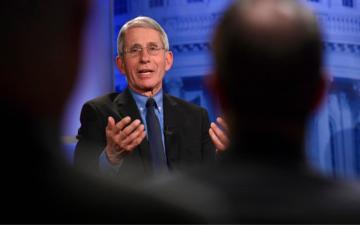
Drawing the Distinction Between Explanatory Journalism and Expedient News
Susan Walsh, Associated Press
Anita Varma is the assistant director of Journalism & Media Ethics as well as Social Sector Ethics. Views are her own.
Suggesting that we need more slow journalism during a global pandemic might initially sound like suggesting that people experiencing famine need more slow-cooked food. The key difference, though, is that in the current digital landscape there is no dearth of updates, reports, and summaries. Most people would find it difficult, if not impossible, to maintain a diet of every publicly verified update available about COVID-19 on a given day. Rather than replacing this news content, then, emphasizing slow journalism on coronavirus would enrich its utility.
Integrating slow journalism into news organizations would mean explicitly distinguishing reporters (who cover briefings, for instance) from slow journalists focused on explaining the long view. Ethical journalism, then, would operate with a distinct set of principles from ethical reporting—both of which remain crucial in a global health crisis.
What might slow journalism look like if implemented across news outlets—not just those that specialize in slow journalism—in the coming months? It would be more of the best of journalism that we have right now. To start, some journalists would be relieved of the pressure of immediate deadlines. Tasked instead with developing explanations of what is happening, how a range of communities are affected, and what the long-term outlook is would remain burdensome even without immediate deadlines, without a doubt, but would serve a distinct—and often unmet—need that people have in crisis: a reasoned account of the meaning of events, beyond “straight documentation” of these events to begin to make sense of them.
Commentators have, in some cases, served this role. Yet commentators are also often poorly positioned to have a breadth of insight into a range of communities, and their outlook may be similarly pressured by recurring deadlines and the pressure to be first in a think-piece rich digital environment. In contrast, journalists are trained to seek grounded verification, which makes them better suited and equipped for the challenge of developing slow journalism.
At their core, the ethics of slow journalism and the ethics of expedient reporting are congruent: both seek to offer people visibility into conditions and changes they may not have directly experienced (yet). Both help orient members of the public to changing conditions. Where they diverge, however, is that slow journalism strives to offer insight at the level of what changes mean, while expedient reporting offers transparency into the tactical dimension of these changes.
For example, as early as February, expedient reporting immediately amplified health authorities’ advice for social distancing between people, limiting the size of social gatherings, and replacing handshakes and hugs with elbow bumps and folded hands. (Comparatively) slow journalism, on the other hand, offered explanation of what “flatten the curve” means, how it works and doesn’t work, and why it matters.
Informing people that global health authorities are advising them to socially distance is, of course, a major priority and a call for slow journalism should in no way be mistaken for the suggestion that immediate updates are dispensable. At the same time, informing people of announcements to socially distance may not suffice to affect change, particularly in a society that has a strong cultural value of individual autonomy—in the absence of also explaining why.
For lean news organizations that are already strained by pressures to provide regular updates on a story that is developing every hour, while also taking precautions to protect staff from exposure to the virus, slowing down to foster more slow journalism may sound like a luxury at best and a laughable proposition at worst. In a moment of growing trepidation that, in some places has expanded into panic, however, news organizations’ public service role is crucially important—and needs to be understood in terms of serving the public’s need for information as well as serving their need for guidance on how to process and interpret what this information means for us all.
